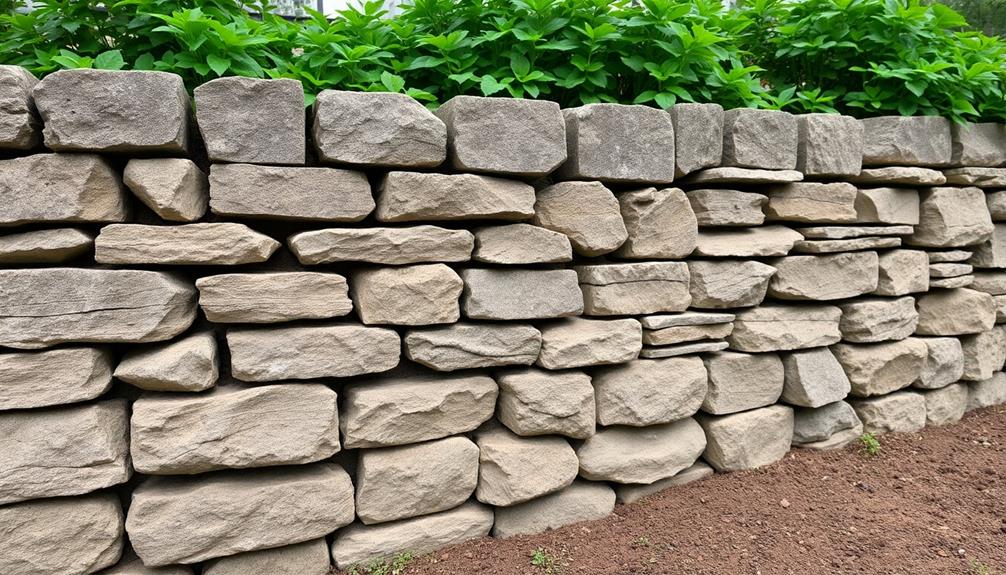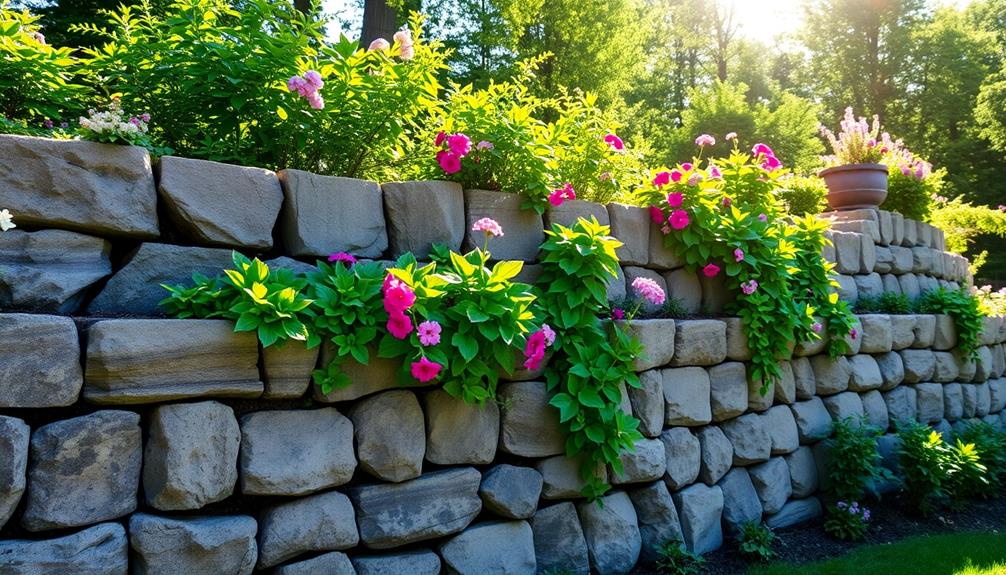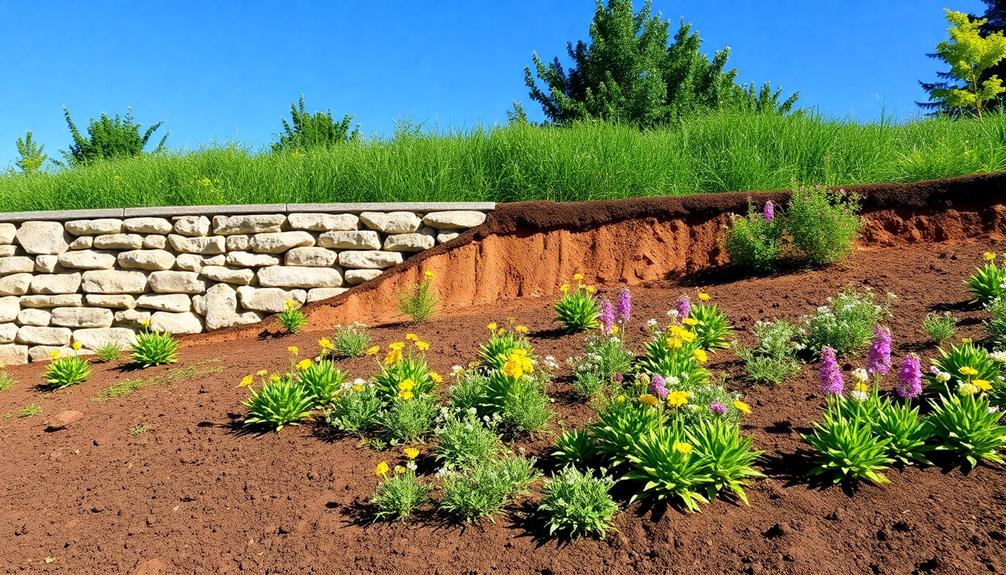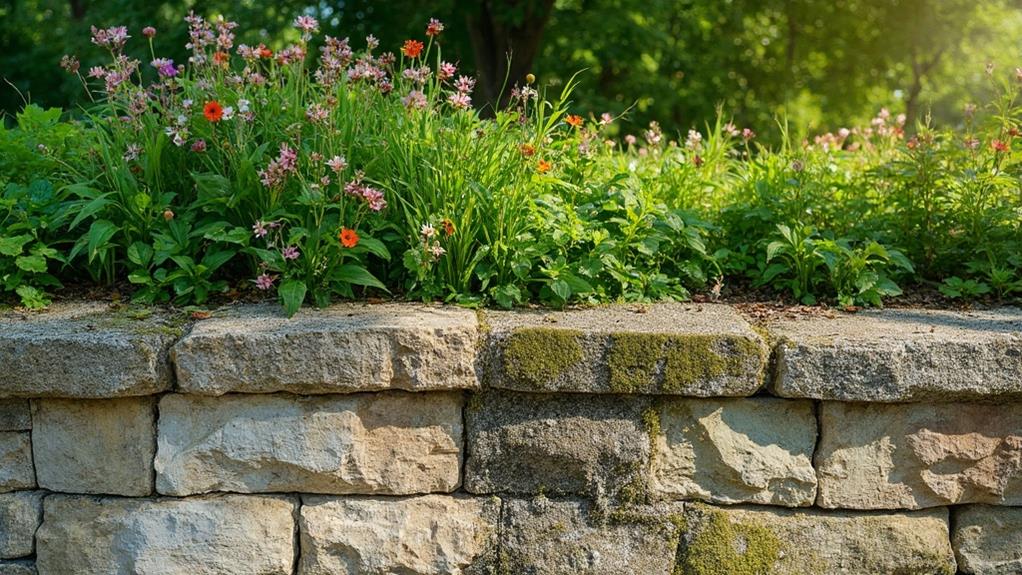Regular maintenance of retaining walls is a critical aspect of preserving their structural integrity and extending their lifespan. Exposed to relentless forces such as soil pressure, moisture, and temperature fluctuations, these structures can suffer from weakening, cracking, or even collapse if neglected. Ensuring robust drainage and addressing signs of wear through routine inspections and timely repairs prevent such failures. Maintenance also sustains the aesthetic appeal and functionality of the wall, contributing to property value and environmental harmony. In addition, it minimizes safety risks and potential liabilities, highlighting its importance for responsible property management. An exploration into maintenance intricacies reveals further insights.
Table of Contents
ToggleWalls Contractor Highlights
- Regular maintenance prevents structural failures by identifying and addressing issues like cracking or shifting before they escalate.
- Ensures optimal drainage, preventing hydrostatic pressure buildup and maintaining the wall's stability and functionality.
- Enhances longevity and durability by protecting against environmental elements and extending the wall's useful lifespan.
- Improves aesthetic appeal by preserving the wall's original design and preventing unsightly deterioration.
- Promotes safety and reduces liability by promptly addressing potential hazards, protecting users and property owners.
Definition of Retaining Walls

Retaining walls are integral structures designed to hold back soil and prevent erosion, serving both aesthetic and functional purposes in various landscapes. These walls can be constructed from a range of materials, including concrete, stone, and timber, each offering distinct advantages and suitability for different types of projects.
In the Twin Cities, retaining wall projects might utilize materials such as limestone, boulders, and granite to cater to local homeowner needs. The design and construction of retaining walls require careful consideration of site-specific conditions such as soil characteristics, load factors, and drainage requirements to guarantee stability and longevity.
Purpose and Functionality
Often overlooked in everyday landscapes, retaining walls serve an indispensable role in both residential and commercial settings. These structures are more than mere decorative elements; they are essential for soil management, preventing erosion, and creating usable spaces on uneven terrain. Retaining walls work by holding back soil and water, thereby stabilizing slopes and preventing landslides. This functionality is particularly pivotal in areas prone to heavy rainfall or where soil erosion poses significant risks to property and infrastructure.
In residential settings, retaining walls can transform sloped plots into functional, level areas for gardens, patios, or driveways, contributing to the property's aesthetic and practical value. In commercial environments, they are critical for maximizing land use, enabling the construction of buildings and infrastructure on challenging sites. These walls are engineered to withstand lateral pressure, whether from soil, water, or other loads, ensuring long-term stability.
Beyond their structural benefits, retaining walls also foster a sense of belonging by seamlessly integrating into the natural landscape, creating harmonious progressions between built and natural environments. This integration not only enhances the beauty of a space but also fosters a sense of community and shared responsibility for maintaining the environment.
Types and Materials
Understanding the various types and materials of retaining walls is fundamental to appreciating their functionality and aesthetic integration into landscapes. Retaining walls are structures designed to hold back soil or rock from a building, structure, or area, effectively preventing erosion and landslides. They serve not only a utilitarian purpose but also enhance the visual appeal of outdoor spaces, creating opportunities for diverse landscaping designs.
There are several types of retaining walls, each suited to different needs and site conditions. Gravity walls rely on their massive weight to resist pressure, typically constructed from concrete or stone. Cantilever walls use a reinforced concrete stem that spreads the load to a structural footing, providing stability for taller installations. Anchored walls employ cables or rods driven deep into the soil, ideal for sites with limited space or where additional reinforcement is necessary.
Materials play an essential role in the durability and appearance of retaining walls. Common materials include natural stone, which offers a timeless, rustic look; concrete, known for its strength and versatility; and timber, providing an organic and cost-effective option. Selecting the right type and material is indispensable for ensuring the longevity and effectiveness of the retaining wall, aligning with both functional needs and aesthetic desires.
Design and Construction
The design and construction of retaining walls are critical in engineering and landscape architecture, serving both functional and aesthetic purposes. Retaining walls are structures crafted to hold back soil, preventing erosion and managing sloped landscapes. Their engineering is a blend of science and art, requiring precise planning and execution to safeguard stability and longevity.
A well-designed retaining wall must address soil pressure, drainage, and the physical characteristics of the site, while also considering environmental factors such as water runoff and seismic activity.
The construction phase involves selecting appropriate materials and techniques suitable for the specific landscape requirements. Common materials include concrete, stone, brick, and timber, each offering distinct advantages in terms of durability and visual appeal. Engineering principles dictate that the foundation must be robust, often involving reinforced footings and proper compaction to withstand lateral earth pressure.
Furthermore, the construction process must integrate drainage solutions to alleviate hydrostatic pressure, which can compromise the wall's integrity. By incorporating weep holes or drainage pipes, water accumulation is managed effectively, enhancing the wall's resilience. Ultimately, successful design and construction not only safeguard the wall's functionality but also enhance the landscape's cohesion, fostering a sense of unity and belonging within the environment.
Benefits

Maintaining retaining walls is essential for preventing structural failures, which can lead to costly repairs and safety hazards. A well-maintained wall not only enhances its longevity and durability but also considerably improves the aesthetic appeal of the surrounding environment.
Retaining walls constructed from a variety of natural and man-made materials require different maintenance approaches, which is why consulting with professionals who provide valuable advice on designs, materials, and methods is advantageous. Additionally, regular maintenance guarantees ideal drainage efficiency, preventing water accumulation that could compromise the wall's integrity.
Prevent Structural Failures
One of the primary benefits of regular retaining wall maintenance is the prevention of structural failures, which can lead to costly repairs and safety hazards. Retaining walls are subjected to varying environmental conditions and stresses over time, including soil pressure, water infiltration, and freeze-thaw cycles. These factors can gradually weaken the structural integrity of the wall, potentially causing it to shift, crack, or even collapse. Regular maintenance, consequently, plays a critical role in identifying and mitigating these issues before they escalate into substantial problems.
The process of maintaining a retaining wall involves a thorough inspection to detect early signs of distress, such as bulging, cracking, or water seepage. By addressing these issues promptly, the risk of structural failure is drastically reduced. Maintenance activities may include reinforcing the wall with additional supports, repairing damaged sections, and improving drainage systems to prevent water accumulation behind the wall.
For communities that value safety and cohesion, ensuring the stability of shared structures like retaining walls fosters a sense of security and mutual responsibility. In this way, regular maintenance not only safeguards the physical environment but also strengthens the bonds within the community, as everyone benefits from a well-maintained and reliable infrastructure.
Enhance Longevity and Durability
Beyond preventing structural failures, regular maintenance of retaining walls substantially enhances their longevity and durability. A well-maintained retaining wall can withstand the test of time, resisting the natural forces that threaten its integrity.
Exposure to environmental elements such as rain, wind, and temperature fluctuations can lead to erosion and deterioration. By conducting regular inspections and implementing timely repairs, property owners can fortify their retaining walls against these challenges, ensuring their structures remain robust and dependable.
Routine maintenance activities, such as cleaning drainage systems and removing vegetation, play a pivotal role in preserving the structural health of retaining walls. These practices prevent moisture accumulation and root intrusion, both of which can compromise the wall's stability.
Additionally, reinforcing weak areas with appropriate materials further extends the wall's lifespan, making it a more sustainable investment.
Investing in the longevity and durability of retaining walls not only brings peace of mind but also fosters a sense of community responsibility. A sturdy retaining wall not only protects individual properties but also contributes to the safety and cohesion of the surrounding area.
Consequently, proactive maintenance is not merely a personal duty; it is a commitment to the collective well-being of the community.
Improve Aesthetic Appeal
Enhancing the aesthetic appeal of retaining walls offers numerous benefits that extend beyond mere functionality. These structures, often seen as purely utilitarian, can seamlessly blend into the surrounding landscape, creating a harmonious environment that fosters a sense of belonging within a community.
A well-maintained retaining wall enhances the overall visual appeal of a property, contributing to its market value and desirability. Regular attention ensures the wall remains free of unsightly cracks, discoloration, and plant overgrowth, which can detract from its appearance.
Incorporating design elements, such as strategic lighting, decorative finishes, or the integration of natural stone, can transform a standard retaining wall into a focal point that complements the architectural style of adjacent buildings. This attention to detail not only showcases a commitment to quality but also creates an inviting atmosphere that encourages social interaction and community involvement.
Moreover, maintaining the aesthetic integrity of retaining walls reflects positively on the property owner, signaling a dedication to preserving the environment and enhancing communal areas. By prioritizing the visual aspects of retaining walls, property owners contribute to a cohesive and attractive neighborhood, fostering pride and a shared sense of identity among its residents.
Optimize Drainage Efficiency
In addition to aesthetic enhancements, optimizing drainage efficiency in retaining walls is fundamental to their structural integrity and longevity. Proper drainage systems are essential for preventing water accumulation, which can lead to hydrostatic pressure buildup. This pressure can compromise the stability of the retaining wall, causing bowing, cracking, or even catastrophic failure. Hence, maintaining an effective drainage system is not merely a precaution but a critical component of retaining wall maintenance.
Incorporating adequate drainage solutions, such as weep holes, drainage pipes, and gravel backfill, guarantees the swift removal of excess water. These systems work in concert to relieve pressure and maintain soil stability behind the wall. Regular inspection and maintenance of these components are crucial to ensure they are functioning correctly and efficiently. Clogged drains or blocked weep holes can defeat their purpose, leading to potential water damage.
Furthermore, optimizing drainage efficiency enhances the wall's performance during adverse weather conditions, instilling a sense of security and belonging among property owners. When retaining walls are steadfast and reliable, they contribute to the overall harmony and safety of the environment, fostering a sense of unity and trust within the community.
Soil Erosion Prevention Tips

In the domain of retaining wall maintenance, implementing soil erosion prevention strategies is vital to ensuring structural longevity and environmental harmony. Key practices include planting vegetation for stability, installing proper drainage solutions, and adhering to a regular inspection schedule, all of which collectively fortify the wall against erosion threats. The following table summarizes these essential tips:
| Prevention Method | Benefits | Implementation Tips |
|---|---|---|
| Vegetation for Stability | Reduces surface erosion | Select native, deep-rooted plants |
| Proper Drainage Solutions | Prevents water accumulation | Use perforated pipes or drainage mats |
| Regular Inspection Schedule | Detects early issues | Schedule bi-annual professional checks |
Vegetation for Stability
Utilizing vegetation strategically can play a pivotal role in enhancing the stability of retaining walls and preventing soil erosion. By selecting the right plants, their root systems can bind soil particles together, reducing the likelihood of erosion that can compromise the structural integrity of retaining walls.
Deep-rooted plants such as native grasses and shrubs are particularly beneficial as they penetrate the soil, providing a natural anchor that stabilizes the earth. These plants not only improve soil cohesion but also contribute to the ecosystem, fostering a sense of belonging to the natural landscape.
Moreover, vegetation serves as a living barrier against rain impact, dissipating the energy of water droplets before they reach the soil. This reduces surface runoff, which is a primary cause of erosion. Additionally, the foliage of these plants can absorb excess moisture, maintaining the ideal level of soil hydration and further preventing erosion.
It is essential to choose plant species that are well-suited to the local climate and soil conditions, ensuring they thrive and effectively contribute to retaining wall stability. By integrating vegetation into your retaining wall maintenance strategy, you not only fortify the wall but also enrich the surrounding environment, creating harmony between nature and engineered structures.
Proper Drainage Solutions
Effective drainage systems are essential for preventing soil erosion around retaining walls. By facilitating the efficient removal of water, these systems greatly reduce hydrostatic pressure, which can otherwise compromise the structural integrity of the wall. Proper drainage solutions involve the strategic installation of components such as perforated pipes, drainage gravel, and geotextiles, each playing a pivotal role in directing water away from sensitive areas.
Perforated pipes, for instance, serve as conduits to channel excess water, while drainage gravel aids in the filtration process, guaranteeing that only water and not soil particles are carried through. Geotextiles, on the other hand, act as a barrier that prevents soil from clogging the drainage system, maintaining its efficacy over time.
Implementing these measures not only extends the lifespan of retaining walls but also fosters a sense of security and belonging within communities, knowing that their landscapes are protected against erosion. Additionally, attention to grading and sloping around the wall guarantees that surface water is directed away efficiently, reducing the risk of pooling. Together, these strategies create a robust defense against erosion, preserving both the functionality and aesthetic appeal of retaining walls in shared spaces.
Regular Inspection Schedule
A key aspect of maintaining retaining walls and preventing soil erosion is establishing a regular inspection schedule. This proactive measure involves evaluating the structural integrity and functional performance of the retaining wall system, ensuring early detection of potential issues that could lead to costly repairs or failures. Inspections should be conducted biannually, ideally in spring and fall, to address seasonal changes and their impact on the wall's condition.
During these evaluations, attention should be paid to signs of bulging, cracking, or leaning, which may indicate underlying structural concerns or improper drainage.
To foster a sense of community and shared responsibility, property owners are encouraged to collaborate with neighbors, local homeowners' associations, or professional inspectors. This collective approach not only optimizes resources but also reinforces a culture of care and stewardship for shared landscapes. Additionally, routine inspections can identify areas where vegetation may be encroaching on the structure, potentially complicating maintenance efforts and contributing to soil erosion.
Walls Contractor FAQ
How Often Should Retaining Walls Be Inspected for Potential Issues?
Retaining walls should be inspected biannually to identify potential issues, fostering a sense of community trust and ensuring safety. Regular evaluations help prevent structural failures, preserving the integrity and longevity of the communal spaces they support.
What Are Common Signs of Damage in Retaining Walls to Look Out For?
Common signs of damage in retaining walls include visible cracks, bulging or leaning sections, water seepage, and soil erosion around the base. Regular inspection and prompt repair guarantee structural integrity, fostering a safe environment for the community.
Can Regular Maintenance Extend the Lifespan of a Retaining Wall?
Regular maintenance can substantially extend a retaining wall's lifespan by identifying and addressing minor issues before they escalate. This proactive approach fosters a sense of community responsibility, ensuring shared spaces remain safe and aesthetically pleasing for all.
What Tools or Equipment Are Needed for Maintaining Retaining Walls?
Maintaining retaining walls requires tools such as shovels, wheelbarrows, and levels, alongside equipment like pressure washers and drainage tools. Engaging in regular upkeep fosters community pride and guarantees these structures remain strong and visually appealing for everyone.
Are There Specific Weather Conditions That Increase the Need for Retaining Wall Maintenance?
Specific weather conditions, such as heavy rainfall, freezing temperatures, and strong winds, can exacerbate wear on retaining walls. These conditions necessitate increased maintenance efforts to guarantee structural integrity and prevent potential failures, fostering safety and community trust.







